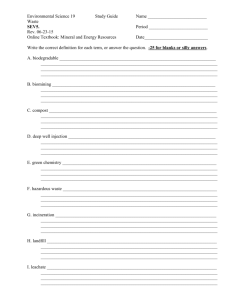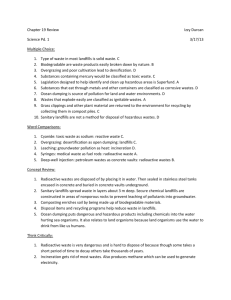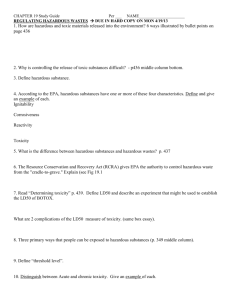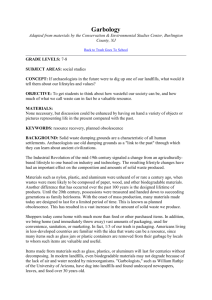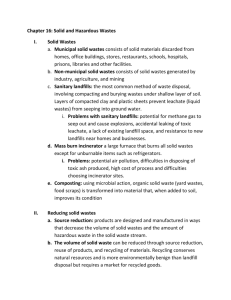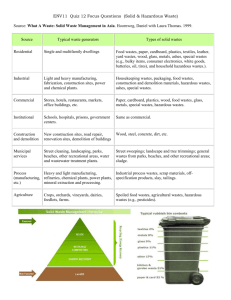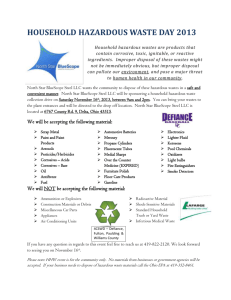waste_unit
advertisement
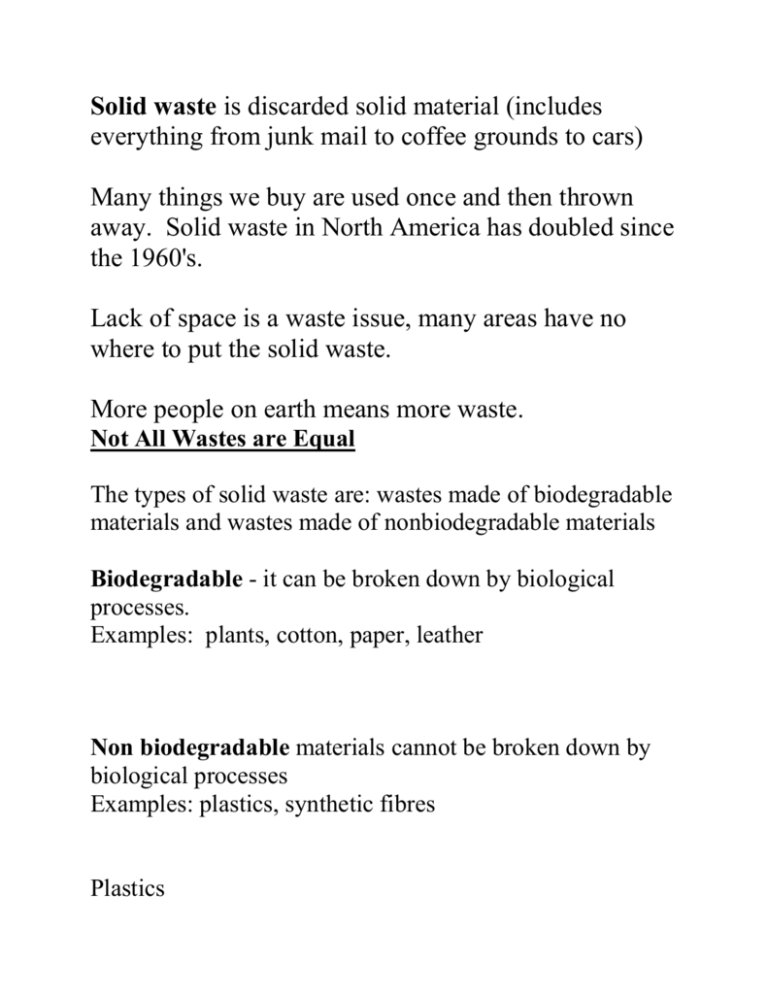
Solid waste is discarded solid material (includes everything from junk mail to coffee grounds to cars) Many things we buy are used once and then thrown away. Solid waste in North America has doubled since the 1960's. Lack of space is a waste issue, many areas have no where to put the solid waste. More people on earth means more waste. Not All Wastes are Equal The types of solid waste are: wastes made of biodegradable materials and wastes made of nonbiodegradable materials Biodegradable - it can be broken down by biological processes. Examples: plants, cotton, paper, leather Non biodegradable materials cannot be broken down by biological processes Examples: plastics, synthetic fibres Plastics Plastic are Nonbiodegradable, they are made up of carbons and hydrogen's, elements that make up most living things but the molecular chain used to make them is not the same as those found in nature. Plastics thrown away may accumulate and last for thousands of years. Types of Solid Waste municipal solid waste - waste produced by households and businesses manufacturing waste - waste such as scrap metal, plastics,paper, sludge and ash mining waste - leftover rock and mineralsAgricultural waste- crop wastes and manure, this waste is biodegradable but the use of fertilizers and pesticides may cause agricultural waste to become more difficult to dispose of because it may harm soil. Solid waste management Landfills - most municipal waste gets sent to landfills Some waste is incinerated and some is recycled Landfills are permanent waste-disposal facilities where wastes are put in the ground & covered each day with a layer of soil, plastic or both. Problems with landfills Shortage of land One problem is leachate, this is liquid that has passed through compacted solid waste in a landfill. It may contain chemicals that could pass into groundwater, making nearby wells unsafe. Monitoring wells and storage tanks are usually installed to prevent leachate. Methane is another problem. Decomposing organic waste produces methane, which is highly flammable. The methane gas is usually pumped out of the landfill and used as fuel. Incinerators Incinerators can reduce solid waste by 75 %. A problem is the waste doesn't get separated before being burned so some materials that shouldn't be burned are & can cause air pollution. Ash is left over and disposed of in a landfill. This ash can be more toxic. Reducing Solid Waste Source reduction is any change in design, manufacture, purchase or use of materials or products to reduce their amount or toxicity before the become municipal waste. Buying Less Buy products with less packaging buy products that can be used more than once Ex. Dish towel instead of paper towel rechargeable batteries instead of regular batteries Bottles Make products that use less material. Make products that last longer. Recycling It's the process of reusing materials or recovering valuable materials from waste or scrap. Names some items that can be recycled: Composting Taking organic material and allowing it to decompose, thereby returning nutrients to the soil. What can go in composters? Hazardous waste - any waste that is a risk to the health of humans or other living things. Deep-well injection - deep-well disposal of hazardous waste surface impoundment - a natural depression or a human- made excavation that serves as a disposal facility that holds an accumulation of wastes. 1. Hazardous waste is either corrosive, explosive or toxic (can be solid, liquid or gas). 3. incineration - waste can become more toxic, less waste remains land disposal - deep-well injection -surface impoundment biologically treating exporting 4. Bacteria can be used to breakdown the hazardous waste ie crude oil, cyanide 5. Yes I would oppose the site, due to possibilities of leakage, smell, noise, no one wants toxic waste stored near the place they live. 6. Oil will soak into the ground, contaminate the soil, could eventually end up in water supply . Hazardous waste Wastes that are a risk to the health of humans or other living organisms. It may be in the form of solid, liquid or gases. Tend to be toxic, corrosive or explosive Some hazardous wastes can be coverted into nonhazardous substances. Land Disposal Deep-well injection - wastes are pumped deep into the ground where they are absorbed into a dry layer of rock below the level of groundwater. Then covered with cement. Surface impoundment - - basically a pond with a sealed bottom. Wastes may be put in barrels and buried in landfill sites. As long as these sites are properly maintained to problems should arise.

